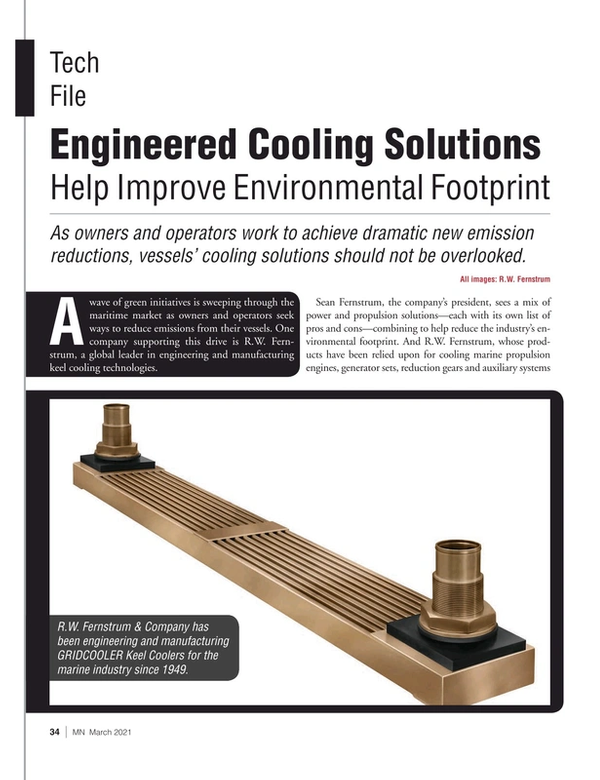
Tech File: Engineered Cooling Solutions Help Improve Environmental Footprint
As owners and operators work to achieve dramatic new emission reductions, vessels’ cooling solutions should not be overlooked.
A wave of green initiatives is sweeping through the maritime market as owners and operators seek ways to reduce emissions from their vessels. One company supporting this drive is R.W. Fernstrum, a global leader in engineering and manufacturing keel cooling technologies.
Sean Fernstrum, the company’s president, sees a mix of power and propulsion solutions—each with its own list of pros and cons—combining to help reduce the industry’s environmental footprint. And R.W. Fernstrum, whose products have been relied upon for cooling marine propulsion engines, generator sets, reduction gears and auxiliary systems on board vessels of all sizes worldwide for decades, has the experience and technology to support the green push.
“We’ve done work with natural gas power engines, we’ve done work with fuel cells, hydrogen and so on, in cooling those systems. We’ve done work with a number of different hybrid systems,” Fernstrum says, adding that his company’s engineered solutions can help to reduce emissions even further. “We’re able to simplify things quite a bit on the cooling side and actually in many cases we can reduce the power or energy requirements for the overall cooling system.”
In particular, the company’s signature closed-loop GRIDCOOLER keel cooler helps improve propulsion efficiency while also driving down emissions. “You’re able to eliminate auxiliary pumps that you would need to if you’re bringing seawater on board. You don’t have to bring the seawater on board, so you don’t have seacocks, you don’t have strainers, you don’t have seawater piping; all of that’s gone along with the auxiliary pump, which that can siphon off one, two percent of your total power off of an engine,” Fernstrum says. “So, if you can recapture that, that’s definitely a big plus, especially when you’re trying to dial in these energy requirements on these vessels.”
R.W. Fernstrum’s closed-loop systems also enable vessel owners to eliminate another type of emissions. “When you’ve got an open cooling system, you’re pulling the seawater on board, you’re putting it through the strainers, you’re putting it through the engines, you’re doing all of that and then what are you doing? It’s going right off board again. It’s another source of emissions,” Fernstrum says. “With a closed cooling system, you don’t have that. That’s all gone.”
For R.W. Fernstrum, the advent of electric and hybrid systems on vessels has brought in new business. On Maid of the Mist’s new fully electric tour ferries James V. Glynn and Nikola Tesla, for example, the firm supplied GRIDCOOLERS to cool the battery chillers as well as the propulsion and control systems. Notably, the keel coolers on board the aluminum-hulled fresh water catamarans are aluminum instead of the traditional copper nickel. “We’ve got that kind of flexibility in our design,” Fernstrum says.
Another noteworthy green vessel equipped by R.W. Fernstrum is the Red and White Fleet’s hybrid-electric tour boat Enhydra. “[The vessel has] more of a centralized cooling system, and we’re cooling that cooling loop, which has a number of different hybrid components on it. We’re using tranter plate and frame heat exchangers,” Fernstrum says. “We’ve got a lot of different options that we can bring to the table for any given needs that somebody would have.”
Read Tech File: Engineered Cooling Solutions Help Improve Environmental Footprint in Pdf, Flash or Html5 edition of March 2021 Marine News
Other stories from March 2021 issue
Content
- Interview: Jennifer Carpenter, AWO President & CEO page: 10
- Congress Provides Last-minute Help for Small Inland and Coastal Ports page: 15
- Maritime Groups Pleased with WRDA 2020 page: 22
- Five New Ships Poised to Transform US Maritime Training page: 28
- Tech File: Engineered Cooling Solutions Help Improve Environmental Footprint page: 34
- Tech File: Smart Protective Coatings Project page: 36
- Autohydro: User-friendly Engineering Software for Class Approval page: 37


